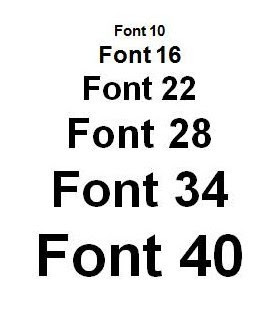Deciphering the Tiny Print: When Font Size Becomes a Barrier
Have you ever squinted at a document, struggling to decipher the minuscule characters crammed onto the page? We live in a world saturated with information, yet sometimes accessing that information feels like deciphering a secret code. Tiny print, almost invisible to the naked eye, can be a significant barrier, excluding many and frustrating countless others. This isn't just about aesthetics; it's about accessibility, usability, and respect for the reader.
The problem of diminutive font sizes isn't new. From dense legal contracts to medicine labels, small print has long been a source of frustration. But in our increasingly digital world, where we consume information on a variety of devices and in various formats, the issue has become more pronounced. We encounter tiny print everywhere, from websites and emails to brochures and packaging. This widespread presence makes understanding the implications of inadequate font sizes more critical than ever.
The origins of using small print can be traced back to a desire to save space and reduce printing costs. Historically, printing was expensive, and minimizing the area used meant lower expenses. This practice, however, often came at the expense of readability. Today, while digital printing has reduced some of these cost constraints, the habit of using small fonts persists. This isn't always malicious; sometimes, it's simply a matter of oversight or a lack of awareness about the impact of font size on the reader.
The importance of addressing insufficient print sizes lies in its direct connection to accessibility. Individuals with visual impairments, including those with age-related macular degeneration or other eye conditions, are particularly affected by small fonts. For them, tiny print can render information completely inaccessible. But even those with perfect vision can experience eye strain, headaches, and frustration when confronted with excessively small text, especially for extended periods.
One of the core issues related to inadequate print sizes is its impact on comprehension. When readers struggle to decipher individual words, they lose focus on the overall message. This can lead to misinterpretations, missed information, and a generally negative user experience. Whether it's a crucial instruction on a medication label or a vital detail in a legal document, the consequences of illegible print can be significant.
Understanding readability is key to addressing the problem of small print. Readability refers to the ease with which a text can be read and understood. It's influenced by a variety of factors, including font size, font style, line spacing, and contrast. A simple example is comparing a 10-point font with a 6-point font. The larger font is significantly easier to read and comprehend.
While there are rarely benefits to intentionally using excessively small font sizes, understanding the motivations behind their use can be helpful. One could argue that in some highly specialized fields, tiny fonts might be used to condense vast amounts of data into a limited space. However, this often comes at the cost of readability.
Advantages and Disadvantages of Small Print Sizes
| Advantages | Disadvantages |
|---|---|
| Potentially fits more information in a limited space (though often at the expense of readability) | Reduces readability and accessibility |
| Can (misguidedly) be perceived as more formal or dense | Causes eye strain and frustration |
| May reduce printing costs (though less relevant in the digital age) | Leads to misinterpretation and missed information |
Frequently Asked Questions:
1. What is considered a minimum acceptable font size for print? Generally, 12-point font is recommended for body text.
2. How can I increase the font size when printing from a website? Use your browser's zoom function or adjust the print settings.
3. Are there legal requirements for font sizes on certain documents? Yes, some regulations exist for specific industries, like pharmaceuticals.
4. How can I improve the readability of my printed documents? Use a clear font, adequate line spacing, and good contrast.
5. What are some good fonts for readability? Times New Roman, Arial, and Calibri are generally considered readable.
6. How does font size affect accessibility? Small fonts exclude people with visual impairments.
7. What tools can I use to check the readability of my text? Online readability calculators can help.
8. How can I advocate for larger print sizes? Provide feedback to businesses and organizations using small print.
Tips and tricks: Use the "Ctrl" and "+" keys to zoom in on digital documents. When printing, adjust the "scale" option in the print dialog box. If you frequently encounter small print, consider using a magnifying glass.
In conclusion, the issue of excessively small print sizes isn't merely a design quirk; it's a fundamental barrier to access and comprehension. While historical reasons and ingrained habits contribute to the persistence of tiny fonts, the negative impact on readability, accessibility, and user experience is undeniable. By understanding the importance of legible text and implementing simple solutions like increasing font sizes, using clear fonts, and prioritizing accessibility, we can create a more inclusive and user-friendly environment for everyone. Don't let small print diminish the power of your message. Make your content accessible, readable, and respectful of your audience by choosing appropriate font sizes. Start prioritizing readability today. It's a small change that makes a big difference.
Supercharge your whatsapp mornings good morning message mastery
Craigslist cars and trucks columbia sc your guide to navigating the local auto market
The marvel of the human body understanding our physical form

:max_bytes(150000):strip_icc()/2016_fonts-5c8c171cc9e77c0001eb1bf1.jpg)













